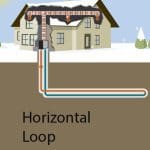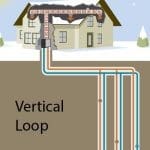Step 1: System Design & Loop Size
As a qualified geothermal company, we expertly design your geothermal unit with these results in the forefront of our mind.” First, we design the geothermal system and size the loop for your unique home. The size of your home will dictate the size of the equipment, and the age and construction of your home will dictate the quantity of loop. Soil type and climate conditions also affect the loop field size. Dense soils such as rock and clay hold and transfer more heat. Sandy soils absorb less heat. As a general rule of thumb, the drier the ground the larger the loop field required. Sizing a geothermal heat pump is an intricate process done by our qualified installers. Concentrating only on the inside equipment is a mistake commonly made by many contractors. We start by analyzing the heating and cooling demands of your home. From there we will be able to calculate the right size geothermal heat pump. Systems are generally sized in tons. An average home might be 3 tons, a larger home might be 6 tons. Never choose on cost alone. An undersized system will strain to reach your desired heating and cooling needs because the heat pump will try to make up for its size by using more electricity, resulting in higher utility bills. An oversized system also comes with problems; it can produce too much airflow resulting in short run times. This means the system cycles on and off frequently, reducing efficiency and increasing utility bills. An oversized system also decreases the comfort level in the home. Short run times during the summer will cool the room but fail to remove humidity, leaving your home clammy and sticky. Oversized equipment can also overshoot the thermostat setting causing a home to overheat in the winter and become an icebox in the summer.
Step 2: Outdoor Drilling & Loop Feild Installation
Our drilling and loop installation can be done on new construction or existing homes. Loop fields can be installed vertically or horizontally. What’s the difference? It’s only in the way the pipe is inserted in the ground, no orientation is “better” then another as they all work effectively. Your ground loop orientation will depend on available space, ground conditions and surrounding environment.
Directional Loop Field
The directional drilled loop field is our most popular method. It is neat, clean and offers the best thermal transfer as the pipes are in direct contact with virgin-native soils. We are able to deploy this method on almost any property, even under an acre.

Vertical Loop Field
A vertical loop field is the most common installation process for a geothermal heat pump that is installed on smaller properties. During a vertical loop field installation a series of holes are drilled, each between 150-200 feet deep. Then, piping is fed down these holes and connected in a loop pattern. Once all of the pipes are connected together outside of the home they are threaded into your home and attached to the heat pump unit.

Low Impact Drilling Method: Our neat, clean, low impact drilling method is patent pending. If you have a small lot, extensive plantings, mature trees, new driveway, above ground & underground obstructions, irrigation and landscape lighting. . . DON’T WORRY! Our unique patented drilling method, greatly reduces the impact on your property, construction time and unsightly excavations. Our drilling method provides superior thermal-conductivity over any other installation method without the damage to your trees and property. The loop field will last a lifetime, has no moving parts and requires no maintenance. At Geothermal Professionals we are fully equipped and able to handle any drilling job
Step 3: Indoor Installation & Calibration
RETROFIT INSTALLATION -We will remove and dispose of your existing system, provide drilling, tie -in, pumps, the geothermal heat pump, electrical, ducting, thermostat, flush fill and calibrate in about two and a half weeks. The geothermal heat pump itself is about the size of a conventional furnace, very quiet and will last twice as long.
EXISTING SYSTEM REPLACEMENT – If we are replacing an existing system, the old furnace and air conditioner will be removed, the new unit will be put in place on the same day for temporary heat (if winter) and attached to the existing duct work. Some duct work modification will be needed. A replacement system consists of new duct work transition fittings, new flow center and pumps, new condensate lines, new pad, new auxiliary heat module, new thermostatic controls and a flush with calibration for perfect performance. Normally we quote one week for the installation time.
NEW CONSTRUCTION – For new construction, we provide custom sheet metal design and fabrication, drilling and loop field installation. We will install the system in the appropriate location and connect it to duct work. Once the unit is in place and the loop field is finished the two are joined, filled, and thoroughly tested.
The installation of your geothermal system is provided by a team of year round/permanently employed gentlemen . All new installations are under the direction of Owner, Dan Fant. Dan is a licensed installer with comprehensive training and over 15 years of experience installing and servicing geothermal systems.
BRAND EQUIPMENT – We specialize in installing Enertech Global equipment; in particular, the Hydron Module Revolution2 brand. Hydron Module geothermal heat pumps are hand assembled right here in the United States and are the only 5 star rated geothermal system on the market today. The Hydron Module product is the only geothermal system in the world that is built with an all aluminum micro channel heat exchanger. The Hydron Module is the world’s best manufacturer of residential ENERGY STAR® qualified geothermal heat pumps.
